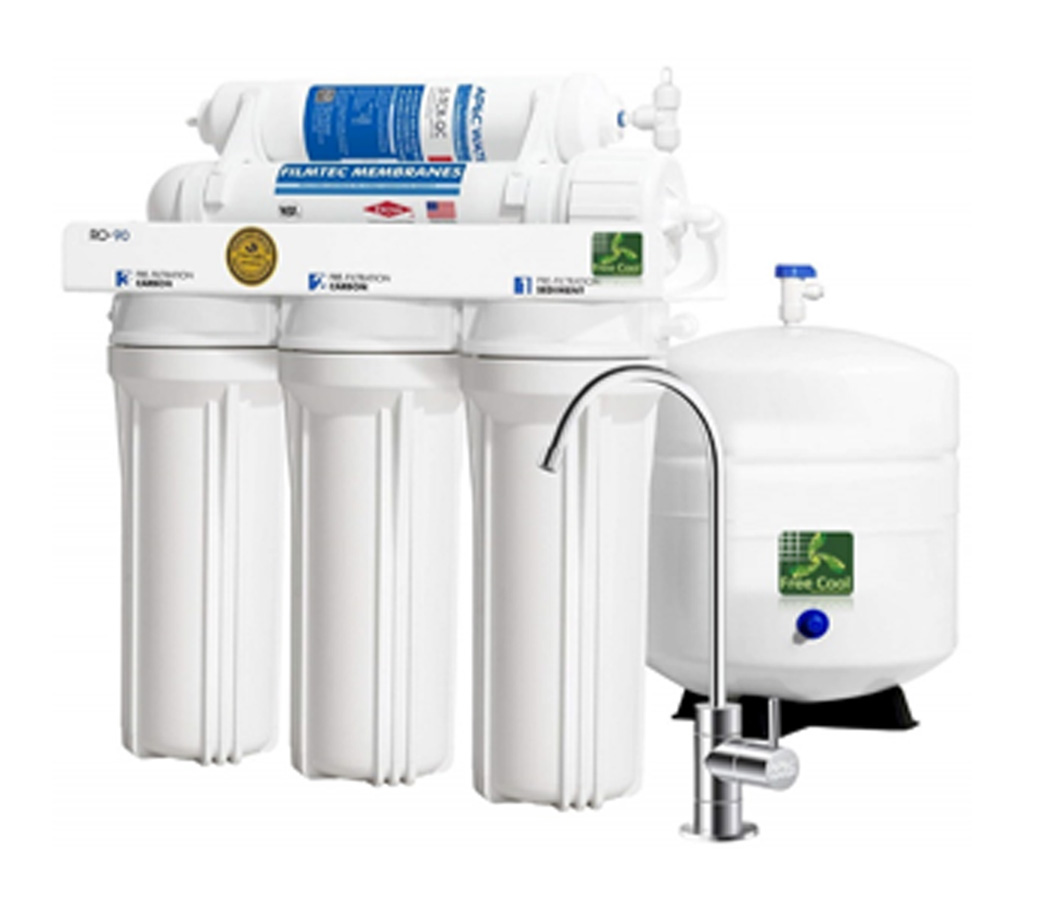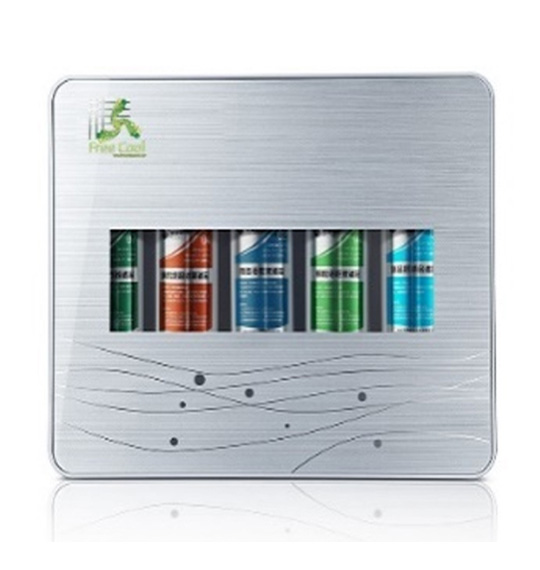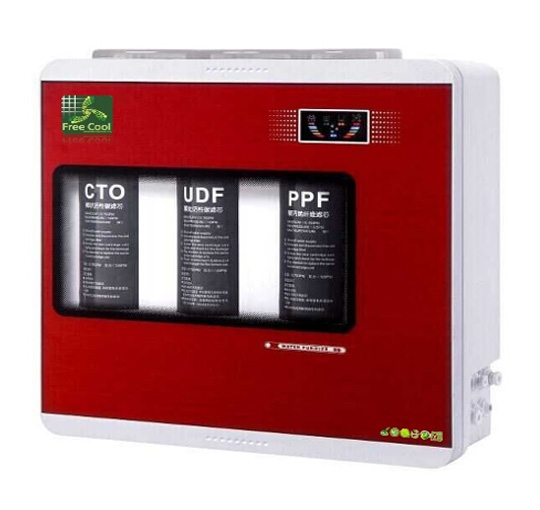How It Works
Water Purification Systems

UNDERSTANDING RO WATER FILTRATION & PURIFICATION
-
1. Why is RO a Good Water Filtration Option?
-
2. What is Reverse Osmosis & How Does Reverse Osmosis Work?
-
3. What Does an RO Filter System Do?
-
4. How Does an RO Membrane Work?
-
5. Are All RO Drinking Water Systems the Same?
-
6. How Much Maintenance Does an RO System Require?
-
7. RO Frequently Asked Questions
How Do Reverse Osmosis Filter Systems Work & What Do They Do?
If you’re looking for a water filter that will provide outstanding drinking water for your home or business, Reverse Osmosis (RO) filtration is one of the most popular and best water filtration methods available. In simple terms, reverse osmosis works as water is forced across a semi-permeable membrane, leaving contaminants behind that are flushed down the drain. The clean drinking water collects in a holding tank.
Millions of People households and businesses love Reverse Osmosis (RO) because:
- RO produces great-tasting water
- RO is effective and safe
- RO filtration is fully automated
- RO systems are reasonably priced
Below you will find diagrams, charts and explanations to answers your questions about RO systems. If you have other questions which are not answered here, please visit our our main water education page or Contact Us.
1Why is Reverse Osmosis a Good Water Filtration Option?
We’ve been in the water filtration business since 1989 and have found Reverse Osmosis filtration to consistently be one of the best ways to achieve superior water for the home and business.
Why Choose
Reverse Osmosis
If you're searching for a water filtration system that will give you outstanding water...
Here are a few reasons to consider RO:
1Improves Taste
RO filtration improves taste, odor and appearance of water by removing contaminants that cause taste and odor problems.
2Saves Money
With an RO system, you can cancel your water delivery service and stop purchasing cases of bottled water. Reverse Osmosis filtration provides “better-than-bottled water” quality water for just pennies per gallon.
3Simple Maintenance
RO systems have very few moving or replaceable parts make RO systems easy to clean and service.
4Removes Impurities
RO systems remove pollutants from water including nitrates, pesticides, sulfates, fluoride, bacteria, pharmaceuticals, arsenic and much more. An RO systems’ carbon filter will also remove chlorine and chloramines.
Find out why millions of households love reverse osmosis
Reverse Osmosis filtration is the perfect solution if you’re looking to improve the taste, odor and appearance of your water. Here are some of the most common applications for RO technology:
Common Commercial Reverse Osmosis (RO) System Applications:
- Food & Beverage Industry
- Agriculture
- Boiler Feed
- Disaster Relief
- Environmental
- Hospital
- Hotel
- Marine
- Military
- Mining
- Pharmaceutical
- Power & Energy
2How Does Reverse Osmosis Work?
How does Reverse Osmosis remove impurities?
Reverse Osmosis water purification process is a simple and straightforward water filtration process. It is accomplished by water pressure pushing tap water through a semipermeable membrane to remove impurities from water. This is a process in which dissolved inorganic solids (such as salts) are removed from a solution (such as water).
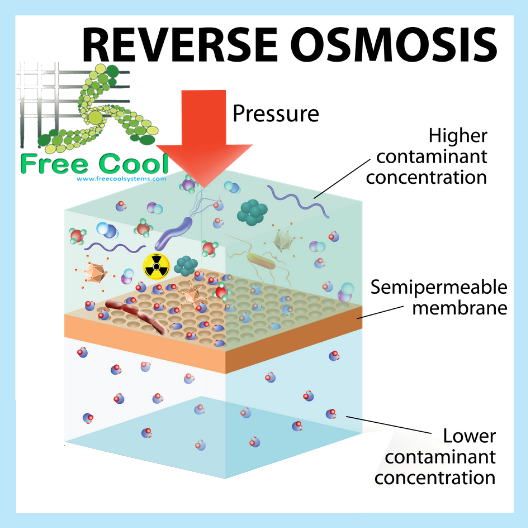
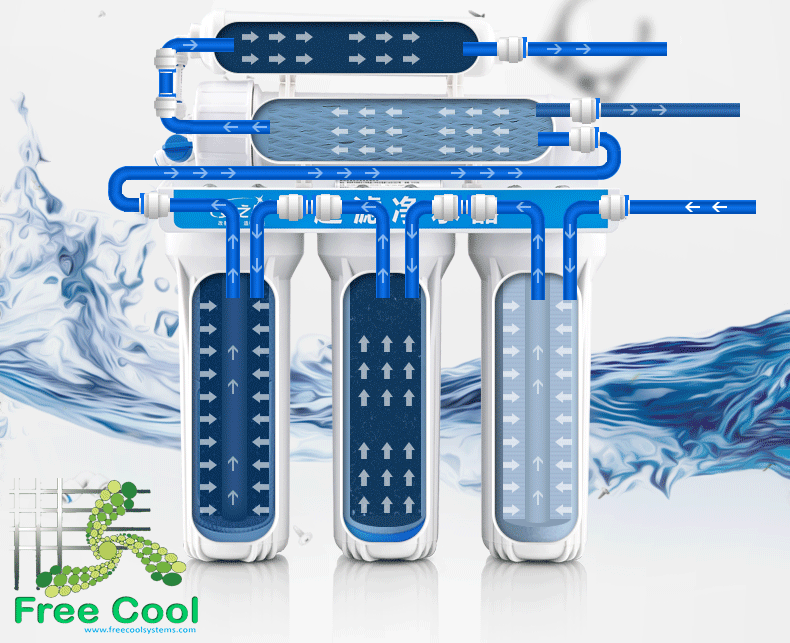
A few impurities found in tap water that can be removed with Reverse Osmosis filtration technology:
- Fluoride
- Lead
- Chlorine & Chlormamine
- Pesticides
- Detergents & more
- Nitrates & Sulfates
What happens to the contaminants that don’t pass through the membrane?
When household water pressure pushes water through the RO membrane and additional filters, such as sediment or carbon filters, the impurities are filtered out and subsequently flushed down the drain. What is left, is delicious, clean-tasting drinking water. Note that many RO units incorporate a 4 or stage process for optimal water quality.
You may be interested to know that Reverse Osmosis technology is not new. In fact, RO processes began being utilized by municipalities back in 1977. Since then, Reverse Osmosis has become increasingly popular because it is safe, cost-effective, and easy to maintain.
RO Filter Systems: What are the basic components of an RO System?
Generally, residential "Point Of Use" POU RO systems are installed and stored under the kitchen sink. Regarding the common components of a four to five-stage RO system, note that:
- Most RO systems look similar and have the same basic components.
- Although most RO systems look and work basically the same way --they differ in the QUALITY of their components.
Basic Components of a Reverse Osmosis System:
- Cold Water Line Valve: Valve that fits onto the cold water supply line. The valve has a tube that attaches to the inlet side of the RO pre filter. This is the water source for the RO system.
- Pre-Filter(s): Water from the cold water supply line enters the Reverse Osmosis Pre Filter first. There may be more than one pre-filter used in a Reverse Osmosis system, the most common being sediment and carbon filters. These pre-filters are used to PROTECT the RO membranes by removing sand silt, dirt, and other sediment that could clog the system. Additionally, carbon filters may be used to remove chlorine, which can damage the RO membranes.
- Reverse Osmosis Membrane: The Reverse Osmosis Membrane is the heart of the system. The semipermeable RO membrane is designed to remove a wide variety of both aesthetic and health-related contaminants. After passing through the membrane, the water goes into a pressurized storage tank where treated water is stored.
- Post filter(s): After the water leaves the RO storage tank, but before going to the RO faucet, the treated water goes through a final “post filter”. The post filter is usually a carbon filter. Any remaining tastes or odors are removed from the product water by post filtration “polishing” filter.
- Automatic Shut Off Valve (SOV): To conserve water, the RO system has an automatic shut off valve. When the storage tank is full, the automatic shut off valve closes to stop any more water from entering the membrane and blocks flow to the drain. Once water is drawn from the RO faucet, the pressure in the tank drops; the shut off valve then opens to send the drinking water through the membrane while the contaminated wastewater is diverted down the drain.
- Check Valve: A check valve is located in the outlet end of the RO membrane housing. The check valve prevents the backward flow of treated water from the RO storage tank. A backward flow could rupture the RO membrane.
- Flow Restrictor: Water flowing through the RO membrane is regulated by a flow restrictor. There are many different styles of flow controls, but their common purpose is to maintain the flow rate required to obtain the highest quality drinking water (based on the gallon capacity of the membrane). The flow restrictor also helps maintain pressure on the inlet side of the membrane. Without the additional pressure from the flow control, very little drinking water would be produced because all the incoming water would take the path of least resistance and simply flow down the drain line. The flow control is most often located in the RO drain line tubing.
- Storage Tank: The standard RO storage tank holds from 2 - 4 gallons of water. A bladder inside the tank keeps water pressurized in the tank when it is full. The typical under counter Reverse Osmosis tank is 12 inches in diameter and 15 inches tall.
- Faucet: The RO unit uses its own faucet, which is usually installed on the kitchen sink. Some areas have plumbing regulations requiring an air gap faucet, but non-air gap models are more common
- Drain line: This line runs from the outlet end of the Reverse Osmosis membrane housing to the drain. The drain line is used to dispose of the wastewater containing the impurities and contaminants that have been filtered out by the reverse osmosis membrane.
Diagram of a Reverse Osmosis System with Basic Components:
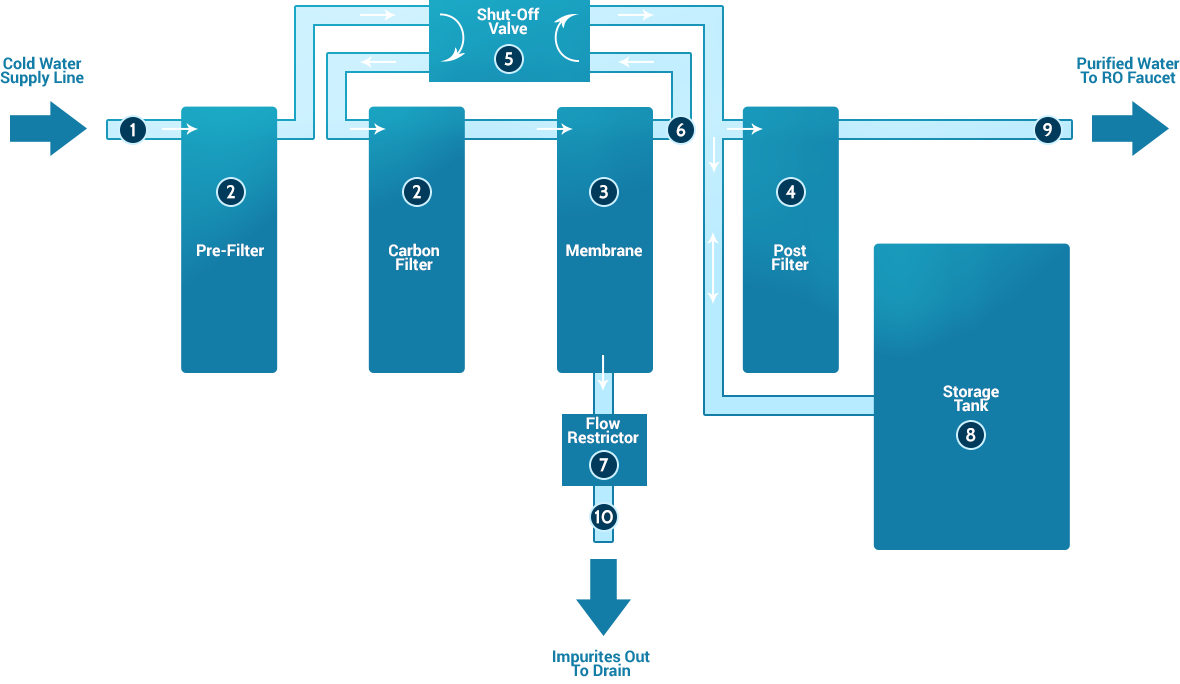
3What does a Reverse Osmosis system do?
Public water suppliers work hard to provide clean water for their customers. The problem is that there are many contaminants, especially those that cause taste and odor issues, which are simply not EPA regulated. These contaminants can easily penetrate aquifers, streams and rivers, bringing impurities straight to your water lines.
Produce Outstanding Drinking Water with Reverse Osmosis
That’s where Reverse Osmosis comes in. With a Reverse Osmosis filtration system, you can filter out impurities and produce outstanding drinking water for your home or business.
4How does a Reverse Osmosis Membrane work?
Reverse Osmosis (RO) is a water treatment process that removes contaminants from water by using pressure to force water molecules through a semipermeable membrane. During this process, the contaminants are filtered out and flushed away, leaving clean, delicious drinking water. Reverse osmosis is capable of removing up to 99 percent of 65 different contaminants (see partial list below), including lead, fluoride, chlorine, dissolved salts, and more.
There are generally four stages in the reverse osmosis process:
Sediment Filter:
This pre-filter stage is designed to strain out sediment, silt, and dirt and is especially important as the sediment filter protects dirt from getting to the delicate RO membranes that can be damaged by sediment.
Carbon Filter:
The carbon filter is designed to remove chlorine and other contaminants that affect the performance and life of the RO membrane as well as improve the taste and odor of your water.
Reverse Osmosis Membrane:
The semipermeable RO membrane in your RO system is designed to allow water through, but filter out almost all additional contaminants.
Polishing Filter:
In a four-stage RO System, a final post filter (carbon filter) will “polish” off the water to remove any remaining taste and odor in the water. This final filter ensures you’ll have outstanding drinking water.
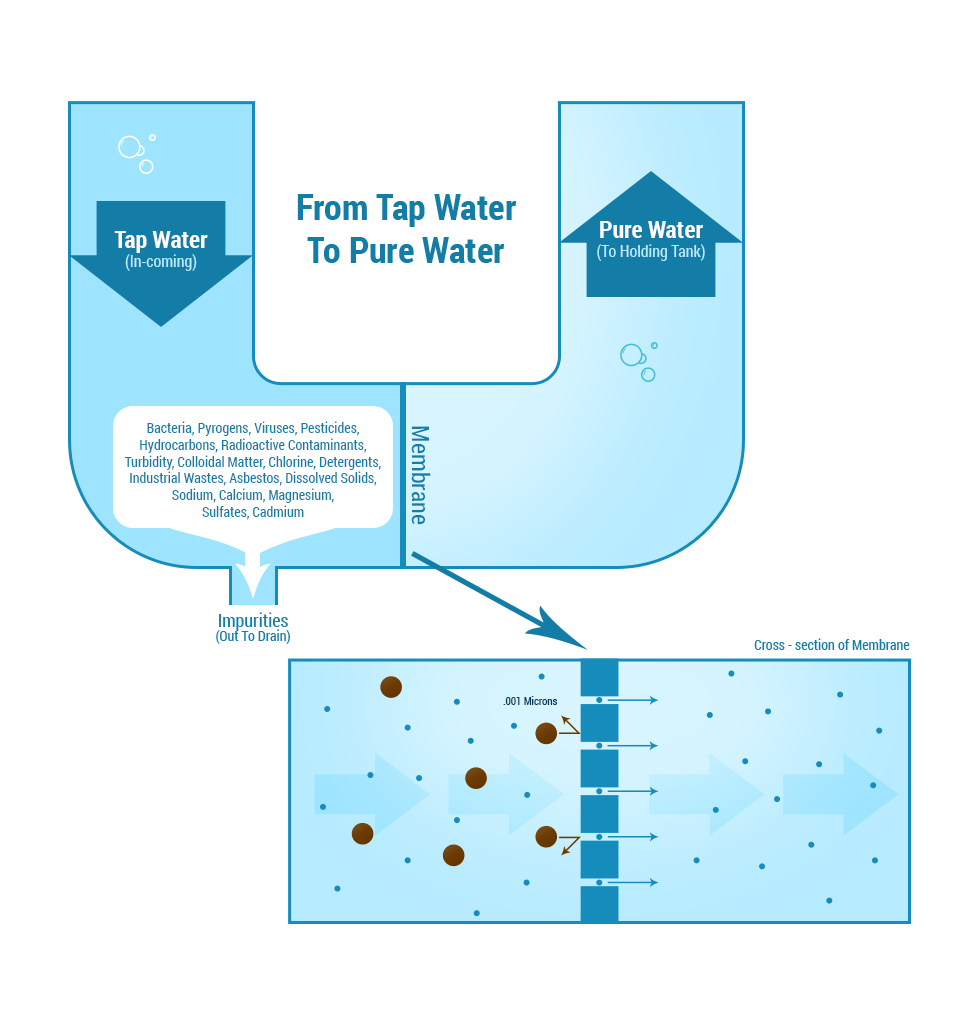
Some factors that may affect the performance of a Reverse Osmosis System:
- Incoming water pressure (most on municipal city tap water have 40-85 psi, but if water pressure is too low, RO system will not operate properly)
- Water Temperature (i.e. cold water takes longer to filter to filter)
- Type and number of total dissolved solids (TDS) in the tap water
- The quality of the filters and membranes used in the RO System (see operating specifications for your system)
Reverse Osmosis Membrane Operating Conditions and Performance Data
|
|
||||||||||||||||||
5Are all Reverse Osmosis drinking water systems and filters the same?
There are many different Reverse Osmosis (RO) water filtration systems on the market. While one RO System may look like the next in terms of design and components, there can be substantial differences between systems.
Reverse Osmosis (RO) Systems Differ in Three Basic Ways:
- Number of stages or filters
- Quality of their components
- Amount of water that can be filtered or produced each day (this amount is in “gpd” or gallons per day)
Quality components are the key to an optimal functioning RO System.
In our 25+ years in the industry, we’ve found that the quality of components is truly the key differentiation between systems. This is because RO units manufactured using excellent craftsmanship, as well as superior parts and components are what ultimately produce the best intended results--top-quality water for the home and business.
As you compare RO systems to find the product that is right for you, be sure to ask yourself these 5 questions:
- Does this system have good reviews?
- Does it use quality parts from trusted manufacturers, and are the materials FDA or NSF (National Sanitation Foundation) approved?
- Is the technology up-to-date?
- Some systems have higher contaminant rejection abilities. How does this one compare to others like it?
- Read up on the company. Is it reputable?
We, at FREECOOLSYSTEMS supply Water Purification Filters with Good Quality and also we are servicing the society with our products for nearly 25 years.
6 How much service and maintenance does an RO system require?
Reverse Osmosis drinking water systems are easy to maintain and upkeep costs are minimal.
1. Replacement filters: RO membranes and filters will need to be replaced every 6 months to 2 years depending on the type of filter, your water quality and your water usage volume.
Generally, filters should be changed following this schedule:
- Pre-filters (sediment/carbon filters): Every 6-12 months
- RO Membrane: Every 2-3 years
- Post filter (carbon filter): Every 12 months
- Not sure how often your parts need replacement? Replacement recommendations are listed under each product’s “SPECS”
This guideline is very general. Specific information about how often your membrane or filter should be replaced can be found in the products’ “Specs” or your product owner’s manual. If you’ve purchased a system or filter from us in the past, we will send reminder emails when it comes time to change your filter.
2. Electricity Charges: All of our residential Reverse Osmosis systems require no electricity, running only on water pressure. Some of our larger commercial systems do have to use
electric pumps, but even then the power requirements are minimal.
3. Annual Maintenance: We recommend that you have your RO system sanitized and filters changed once each year. This can be done by the homeowner or by a local
water treatment professional. A water professional can provide needed maintenance service or consult your RO system’s owner’s manual. We also carry kits and the filters
to perform the annual sanitation and filter change if you’re a do-it-yourself type.
How Long Will An RO System Last?
If you properly care for your Reverse Osmosis system (annual cleanings plus change out filters/membranes on time), your system should have a very long lifespan; we’ve seen properly-maintained systems last 10-15 years!
We highly recommend that you purchase replacement filters from us, as we only carry top-quality filters that are designed for optimal performance and reliability.
7Frequently Asked Questions about RO
1. Where is an RO system stored?
Generally, an RO system is installed and stored under the kitchen sink. Under-counter reverse osmosis systems have a holding tank and several phases of filtration. Here’s what happens during the reverse osmosis process of most systems:
Phase One: This is a pre-filtration phase designed to protect the unit’s membranes by reducing fine, suspended materials that can clog the system.
Phase Two: The second phase involves filtration to remove chlorine since chlorine can damage thin film-material membranes.
Phase Three: This is a semi-permeable membrane designed to remove a wide variety of both aesthetic and health-related contaminants. The water goes from here into a pressurized storage tank to hold the treated water.
Phase Four: The final stage in the RO process is usually a carbon post-filtration phase that will remove any remaining aesthetic taste or odors --a “polishing stage”, if you will.
2. Can an RO system be connected to my fridge or ice machine?
Under-the-counter reverse osmosis systems are plumbed to the incoming cold water line, drain, and an independent faucet. But it is possible for a water treatment professional to plumb an RO unit to your fridge and/or ice machine, as well.
The water professional will most likely run a quarter-inch tube from the under-sink RO unit to your fridge. Water pressure is a consideration with some refrigerators, so be sure to refer to your RO system’s owner’s manual as the pressure from the reverse osmosis unit is about two-thirds of the incoming line pressure.
3. How much water can an RO system produce each day?
The typical under-counter reverse osmosis tank is 12 inches in diameter and 15 inches tall. The reverse osmosis system will operate under water pressure ranging from 40 to 100 psig and generate ten to 75 gallons (that’s 45-340 Liters) per day.
4. Is a Reverse Osmosis System Noisy?
Generally, reverse osmosis systems are very quiet-- though you may hear a “gurgling” sound as the “concentrate” or waste water flows from the membrane to the drain. Reverse osmosis is designed so that “crossflow” water flushes the contaminated concentrate away from the system. This flushing keeps the unit from fouling.
If you hear other sounds, such as a “hissing” noise, immediately call your local water treatment professional as there may be a problem with water pressure, the air gap or a leak.
5. Do you need electricity to operate RO?
No. A residential reverse osmosis system simply runs on water pressure from household plumbing and requires no electricity. The exception to this is large commercial or industrial RO systems. These large systems use pumps to feed water through the filtration process.
6. How does RO water compare to bottled water?
Most people prefer reverse osmosis-filtered water over bottled water. An RO system that incorporates carbon filtration will remove chlorine, chloramines, arsenic, pesticides, herbicides and more. The removal of these contaminants not only makes for safer drinking water, but also greatly improves the taste. The RO process leaves trace amounts of minerals and salts which makes for an overall better taste rather than the “flat” taste of distilled bottle water. Best of all, RO-filtered water saves you the expense of bottled water and is better for the environment since you’re not adding water bottles to local landfill.
7. How long will a reverse osmosis system last
With proper maintenance, an RO system can last for many, many years. Filters should be changed at their scheduled replacement times. The carbon, sediment, and final polishing filters are generally changed out every 12 months and the RO membrane filter is replaced every two years. (These are general recommendations but water usage and household size are the determining factors). Occasionally, tubing or the holding tank will need to be replaced, but overall, RO systems are very simple and easy to maintain and will operate for many years.
8. Is an RO system worth it?
Absolutely. Looking at cost alone, RO systems generally cost less than 30-cents per day to own and operate for a family of four. From a cost-savings perspective, since most Americans spend $100/year on bottled water translating to $400/year for the household, and an RO system would save nearly $300/year as it operates for roughly $100/year. And the number crunching doesn’t reveal anything about the health benefits of RO! RO systems can remove harmful contaminants such as pesticides, herbicides, chlorine, chloramine, and arsenic---certainly making an RO system “worth it.”
9. Will reverse osmosis remove minerals that are healthy to keep minerals in water?
Tap water varies with each city and water source. Some tap water is heavy in mineral content which can affect the taste and smell of water. Filtering water with a reverse osmosis system will remove the majority of minerals in water and greatly improve the aesthetics of drinking water. Because minerals in water are in an inorganic state that our bodies cannot digest, removing the minerals does not make RO-filtered water unhealthy. So keep in mind that while minerals are essential for proper health, food is the primary source of the minerals our bodies need to be healthy, and in a form our bodies can digest.
Understanding difference between RO, UF & UV Water Purifier
When we think ‘dirty’ water, our first thought is water-borne diseases. But all along, the real slow killers are contaminants like arsenic, lead, and other poisonous particles that may prove to be fatal in the long run. For such times, it is best to invest in a good water purifier that will remove every harmful particle and solvent, and ensure you stay healthy.
You can choose between UF, UV, RO or a combination like RO UV Water Purifier. It can be confusing trying to distinguish between them all, but we are here to help you!
What is a UV (Ultra-Violet) Water Purifier?
One of the most basic forms of filtration can be done by using a UV Water Purifier, which utilizes UV radiations to kill germs. The water is forced through a tube and exposed to radiations. On the positive side, UV technology is chemical free and easy to maintain. Unfortunately, it cannot eliminate TDS, nor can it eradicate the bacteria that the radiations manage to kill. The dead organisms continue to be present in the water that you eventually consume.
What is an RO (Reverse Osmosis) Water Purifier?
Termed as Reverse Osmosis, an RO Water Purifier is considered to be the best in the market. This water purifier applies force along the area of concentrated water, which flows through a semi-permeable membrane, resulting in pure RO Water. The process doesn’t simply eliminate harmful particles, but also gets rid of dissolved solids, thereby converting hard water into soft water, fit for consumption. It comes enabled with a pre-filter, a sediment filter, a carbon filter, and an RO membrane, among others, that ensure natural minerals and nutrients are retained for a healthy a lifestyle while eliminating only the harmful elements.
If your water is hard and has TDS, it is wise to invest in an RO UV Water Purifier that provides exemplary service.
What is a UF (Ultra Filtration) Water Purifier?
Known for being the next best form of filtration, UF technology works without any electricity and eradicates suspended solids, larger particles and molecules from water through a hollow membrane. This kind of water purifier is capable of killing and eliminating bacteria and microorganisms but does not get rid of the dissolved solids. It cannot convert hard water to soft water, which is something an RO Purifier can do, providing you with clean RO Water. It is wise to use an RO UV Water Purifier, coupled with UF filtration, for the best drinking experience, especially when you are not certain of the TDS Levels in the water.
To make it simpler, here’s a low-down comparing each water purifier, based on each of their features:
RO vs UV vs UF Comparison Chart
|
RO FILTER |
UV FILTER |
UF FILTER |
|
Needs electricity for purification |
Needs electricity for purification |
Does not need electricity |
|
Filters out all bacteria and viruses |
Kills all bacteria and viruses but doesn’t eliminate them |
Filters out all bacteria and viruses |
|
Requires high water pressure and uses an additional pump |
Works with normal tap water pressure |
Works with normal tap water pressure |
|
Removes dissolved salts and harmful metals |
Cannot remove dissolved salts and harmful metals |
Cannot remove dissolved salts and harmful metals |
|
Filters out all the suspended and visible impurities |
Doesn’t filter out suspended and visible impurities |
Filters out all the suspended and visible impurities |
|
Size of membrane: 0.0001 Micron |
No membrane |
Size of membrane: 0.01 Micron |
|
Removes 90% TDS |
No TDS removal |
No TDS removal |
If this was of help and you have chosen between a UF, UV or RO UV Water Purifier, it’s time you check out our complete range of products. Shop Now

